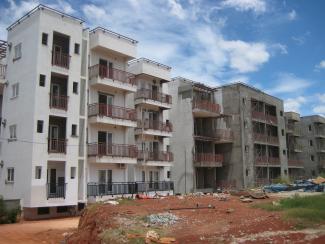India
Creating new standards

India is now one of the world’s largest energy users and originators of CO2 emissions. The economy devours energy at an ever increasing rate, while the Indian middle classes also contribute to increased consumption as a result of their economic success. The Indian government wants to manage the available resources more carefully. One possibility, as in Germany, lies in buildings: Insulated walls, modern windows, heating and cooling systems can save a lot of energy. The International Energy Agency (IEA) estimates that 40 per cent of total energy consumption in India is down to the building sector.
And according to “Germany Trade & Invest”, the Indian construction sector is set to grow by an estimated 10 per cent p.a. in the short term. KfW project manager Corinna Peters therefore believes that “it is logical and can have an enormous effect to apply the efforts here”.
However, these “concealed fuels” which IEA likes to talk about in connection with energy efficiency have to date attracted little attention in India. There are many reasons for this: relatively low electricity prices, an only just emerging market for energy-efficient products and a lack of efficiency standards.
KfW is now working to change this situation and is applying its long-term experience in promoting such projects in Germany. In order to develop a similar system, along with the Fraunhofer Institute for Building Physics (IBP) and “The Energy and Resource Institute” (TERI) in New Delhi, KfW Development Bank has adapted an existing analytical model to Indian conditions.
When supplied with the appropriate data, the program immediately calculates how a newly planned building differs from the Indian average and how much energy can be saved by a certain measure – such as by installing a different kind of air-conditioning system or using another building material. KfW Development Bank has also made available on behalf of the German Federal Government a EUR 50 million credit line to the National Housing Bank (NHB), which for its part offers home loans for energy-efficient building via commercial banks. Buildings which are at least 18 to 30 per cent – depending on conditions and type – below the standard energy consumption are certified; loans for these buildings can then be submitted by commercial banks to the NHB for refinancing. The analytical model exported from Germany calculates whether the new dwellings fulfil these conditions. Some 22,000 dwelling units have now been certified, 2,000 have been financed with a soft loan.
KfW Development Bank will now support the NHB in developing and introducing a label for energy-efficient housing construction so that the scheme becomes widely known in India and established in the housing market. The so-called “KfW efficiency home” is well established in Germany and highly coveted on the German property market. “Other donors are now taking an interest in the NHB and KfW approach,” says Corinna Peters. “They have seen that it works.”
Friederike Bauer







